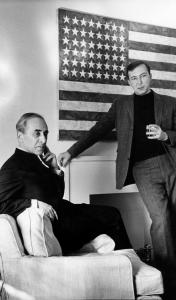 From the mid-1950s until his death in 1999, Leo Castelli, the renowned New York gallery owner who discovered and promoted such artists as Jasper Johns, Robert Rauschenberg, and Roy Lichtenstein, exerted a profound and transformative influence on the aesthetic tastes and commercial practices of the contemporary art world. A beneficiary and instigator of American art’s postwar emergence on the international stage, this Italian-born impresario is generally acknowledged to have been the most important art dealer of the late 20th century.
From the mid-1950s until his death in 1999, Leo Castelli, the renowned New York gallery owner who discovered and promoted such artists as Jasper Johns, Robert Rauschenberg, and Roy Lichtenstein, exerted a profound and transformative influence on the aesthetic tastes and commercial practices of the contemporary art world. A beneficiary and instigator of American art’s postwar emergence on the international stage, this Italian-born impresario is generally acknowledged to have been the most important art dealer of the late 20th century.It is therefore surprising that one can follow Castelli’s story for the first 230 pages of “Leo and His Circle,’’ a mammoth new biography by the French critic and historian Annie Cohen-Solal, without even reaching the point at which the man opens his gallery. But while Cohen-Solal, author of a well-regarded life of existentialist philosopher Jean-Paul Sartre, lavishes more attention on Castelli’s early, preprofessional period than other writers might, she reaps abundant rewards in the process.
Cohen-Solal expands Castelli’s life story into one of sufficient historical and cultural resonance to interest not just art lovers but a general audience as well, offering a richly detailed account of Castelli’s upbringing as a well-to-do Jewish lad in the Italian city of Trieste; unearthing his family’s multigenerational history as merchants and traders with business connections throughout Europe; and narrating in often mesmerizing prose the tragic rise of fascism, which would result both in Castelli’s hasty relocation to the United States at the outbreak of World War II and in the heartrending death of his parents on the run from the Nazis.
The primary flaw in this ambitious and, in many ways, very impressive book is that the great promise of its first half is not altogether fulfilled in the second. Once Castelli arrives in the United States and embarks on his art-world career, Cohen-Solal follows up only haphazardly on many of the themes developed earlier, particularly the central question of how a European Jewish identity — something Castelli and his family alternately cherished and obscured — may have shaped the dealer’s character, personality, and aspirations.
Although this topic could probably have furnished a rich vein of inquiry in discussing Castelli’s personal interactions in New York, Cohen-Solal does not investigate that city’s elaborate social pecking order, either Jewish or non-Jewish, with anything like the depth, insight, or subtlety that she brought to her discussion of the European situation. Content to invoke the vague concept of “Jewish atavism’’ to explain the sudden emergence of Castelli, the erstwhile aimless playboy, as the planet’s foremost merchant of art, Cohen-Solal then proceeds with a fairly narrow account of the personalities and events that shaped the New York art scene, mostly disregarding the larger historical and intellectual questions that made the first half of the book so interesting. Although Cohen-Solal does bring some new anecdotes to this inside-the-art-world discussion, she has little of importance to add in this particular context to what has already been said quite well by other writers, such as Calvin Tomkins.
Still, overall, her extensive archival research and original interviews with Castelli’s friends and relatives allow Cohen-Solal to present a wide-ranging discussion with many compelling observations about what made the dealer tick. He was “a figure happily abounding in European idiosyncrasies while becoming a sort of exemplary postwar American,’’ she rightly notes. Today, one can see the enduring legacy of that synthesis on display in any contemporary art museum or gallery, anywhere in the world.
No comments:
Post a Comment